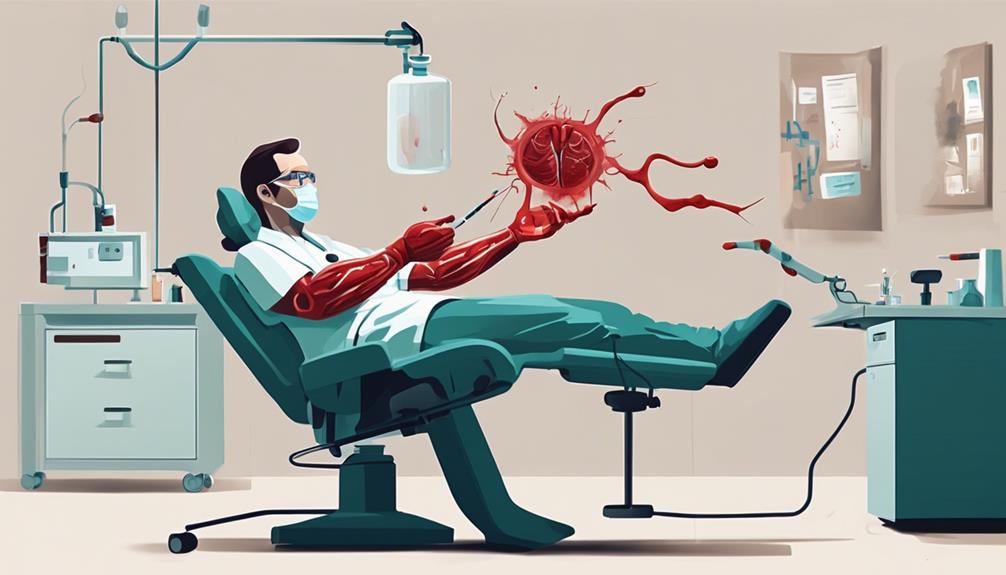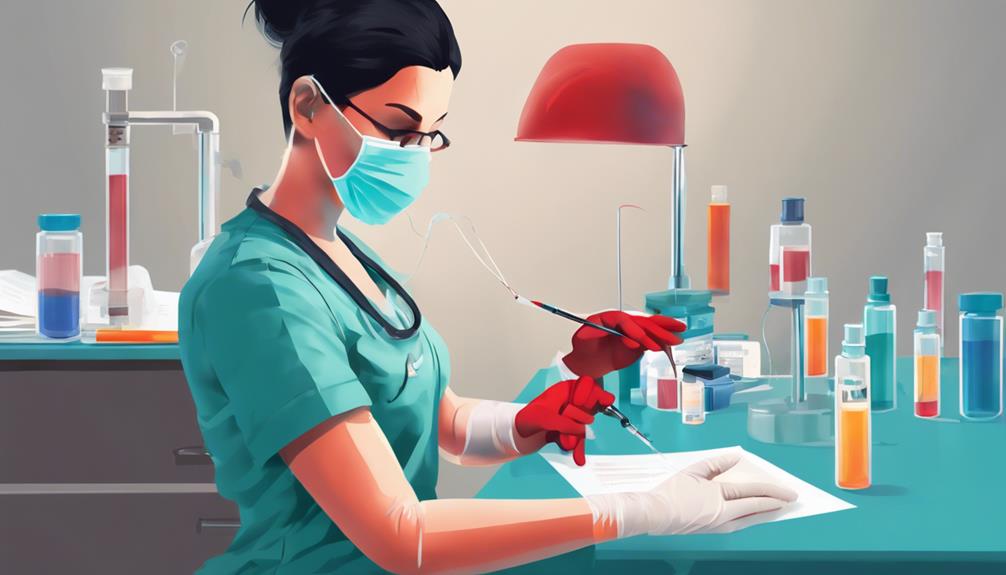Summary
- 1 Definition of Phlebotomy
- 2 History and origins
- 3 Importance in health care
- 4 Responsibilities of the phlebotomist
- 5 Training and Certification
- 6 Frequently asked questions
- 6.1 Can phlebotomists work in non-medical settings?
- 6.2 Are there any risks associated with phlebotomy procedures?
- 6.3 Do phlebotomists need to have strong communication skills?
- 6.4 Is it possible to specialize in a specific type of phlebotomy?
- 6.5 How long does it take to become a certified phlebotomist?
Phlebotomy is the essential process of drawing blood for medical purposes. It is essential for diagnosis and treatment. Qualified professionals handle this activity. It dates back to ancient civilizations and has evolved over time. Phlebotomy is crucial in health care to identify conditions, monitor treatments and preventive health measures. Phlebotomists collect blood samples, prioritize patient comfort and safety, and adhere to strict protocols. Specialized training and certification ensure competence. Interested in finding out more about the importance of phlebotomy in modern healthcare?
Definition of Phlebotomy

Phlebotomy is the process of blood sampling by a patient for purposes of medical analysis or donation. It is an essential part of health care, helping doctors diagnose diseases, monitor treatments and save lives through the blood donations. When you visit a medical facility, the phlebotomist is the experienced professional responsible for collecting your blood samples. They use various techniques to ensure safe and efficient blood collection, such as the venepuncture Or finger pricks.
Phlebotomy plays a critical role in the healthcare system, providing valuable information that guides medical decisions. Your blood samples are sent to the laboratory for analysis, where technicians perform tests to check for conditions such as anemia, infection or diabetes. In addition, phlebotomists adhere to strict protocols to maintain a sterile environment and prevent the risk of infection during the blood draw process.
History and origins
Throughout history, the practice of drawing blood for medical purposes has ancient origins dating back to the earliest civilizations. The art of phlebotomy, from the Greek words 'phlebo' meaning vein and 'tomy' meaning to make an incision, has evolved over the centuries. In ancient times, bloodletting was considered useful for balancing the body's humors and was practiced by the Egyptians, Greeks and Romans. The first documented blood transfusion dates back to the 1600s by Dr. Richard Lower, who successfully transfused blood between animals. Jumping to the early 19th century, phlebotomy became more refined with the introduction of modern medical instruments.
The origins of phlebotomy are deeply rooted in cultural beliefs, medical advancements and the quest for understanding the human body. From bloodletting rituals to the development of blood transfusion techniques, the history of phlebotomy shows the progression of medical knowledge and the importance of blood in the diagnosis and treatment of various conditions.
Importance in health care

In modern health care practices, understanding the importance of blood collection by phlebotomy is crucial for diagnosing and monitoring various medical conditions. Phlebotomy plays a crucial role in health care for several reasons:
- Diagnosis: Blood samples obtained through phlebotomy are essential for diagnosing a wide range of medical conditions, such as anemia, diabetes, infections and more. These tests provide valuable perspectives on a patient's overall health status.
- Treatment monitoring: Phlebotomy is essential to monitor the effectiveness of treatments such as chemotherapy or to manage chronic conditions such as hypercholesterolemia or blood disorders. Regular blood tests help health care providers adjust treatment plans accordingly.
- Disease prevention: Through phlebotomy, health professionals can identify risk factors for diseases at an early stage, allowing preventive measures to be implemented. Regular blood tests can help people make lifestyle changes to reduce the risk of developing serious health problems.
Understanding the importance of phlebotomy in health care ensures accurate diagnosis, effective treatment, and proactive health management.
Responsibilities of the phlebotomist
Phlebotomists play an essential role in health care by skillfully collecting blood samples for diagnostic purposes. As a phlebotomist, your responsibilities go beyond simply drawing blood. You are tasked with ensuring patient comfort and safety during the blood collection process. This involves verifying the patient's identity, explaining the procedure, and calming any fears or anxieties they may have.
Another key responsibility is to label and store blood samples accurately to maintain correct patient identification and prevent contamination of samples. You must also follow strict protocols for sample handling to ensure accurate test results.
In addition, phlebotomists play a significant role in maintaining a clean and organized work environment. Proper disposal of used needles and other biological materials is essential to prevent the spread of infection.
Training and Certification

To become a phlebotomist, you will need to complete specialized training and obtain certification. This process ensures that you have the skills and knowledge needed to safely draw blood and perform related tasks. Here's what you need to know about training and certification:
- Training Programs: Enroll in a phlebotomy training program accredited by organizations such as the National Accrediting Agency for Clinical Laboratory Sciences (NAACLS) or the Accrediting Bureau of Health Education Schools (ABHES).
- Practical Experience: These programs typically include hands-on experiences in which you practice venipuncture techniques under supervision, becoming proficient in drawing blood from patients.
- Certification Examination: After completing your training, you will have to pass a certification exam from organizations such as the American Society of Clinical Pathology (ASCP) or the National Center for Competency Testing (NCCT) to become a certified phlebotomist.
Frequently asked questions
Can phlebotomists work in non-medical settings?
Yes, phlebotomists can work in non-medical environments. They can be used in places such as blood donation centers, research laboratories, or even insurance companies. These roles often involve drawing blood for various reasons, such as research or insurance purposes. Phlebotomists play an essential role in ensuring proper blood collection and are needed in a variety of settings in addition to traditional medical facilities.
Are there any risks associated with phlebotomy procedures?
Yes, there are risks associated with phlebotomy procedures. These can include infection at the puncture site, bruising, fainting, and nerve damage if the needle is not inserted correctly. It is crucial to ensure proper training, use sterile equipment, and follow safety protocols to minimize these risks. Always communicate any concerns or discomfort during the procedure to your phlebotomist to ensure a safe and successful blood draw.
Do phlebotomists need to have strong communication skills?
Yes, phlebotomists absolutely need to strong communication skills. Being able to communicate effectively with patients helps to establish confidence and comfort during the blood drawing process. Clear communication ensures that patients understand what to expect, reducing anxiety and possible complications. In addition, good communication helps phlebotomists collect accurate medical information and handle any unforeseen situations professionally. Thus, honing your communication skills is essential to succeed in this field.
Is it possible to specialize in a specific type of phlebotomy?
Yes, it is possible to specialize in a specific type of phlebotomy. By focusing on a particular area, such as pediatric or geriatric phlebotomy, you can develop skills in handling the unique needs of those patient populations. Specialization can improve your skills and marketability in the field. Consider exploring different options to find the niche that best aligns with your interests and career goals.
How long does it take to become a certified phlebotomist?
To become a certified phlebotomist, it is essential to complete about 4-8 months of training. This involves the completion of a phlebotomy program, which covers topics such as anatomy, specimen collection and safety procedures. Upon completion of the program, you will be required to pass a certification exam to obtain official certification. Remember that specific requirements may vary from state to state, so it is important to check local regulations before beginning training.
